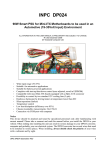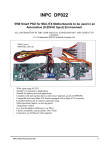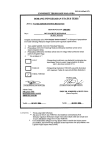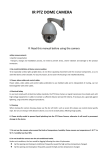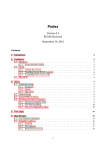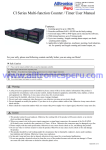Download User manual - DV Industrial Computer
Transcript
INPC DP024 90W Smart PSU for Mini-ITX Motherboards to be used in an Automotive (19-35Volt Input) Environment ALL INFORMATION IN THIS USER MANUAL IS PRELIMINARY AND SUBJECT TO CHANGE. R 0.02 May 2011 DV Industrial Computer Ltd. • • • • • • • • • • • • Wide input range (19-35V) Suitable for automotive applications Suitable for battery powered applications Complete with start-up/shut-down control (user adjusted, saved in EEPROM) Compatible with most Mini-ITX boards equipped with a 20pin ATX connector Long life even at temperature higher than 50°C Silent operation (fanless) Temperature control Low heat dissipation (efficiency over 85%) Chassis mountable, measurements: 39x170x27 Connection via COM-port with computer WatchDog timer to supervise the computer (by commands through the COM-port) Notice This device should be attached and tuned by specialized personnel only after familiarizing with current manual! Please take a moment and read this manual before you install the DP024 in your vehicle. Often rushing into installing the unit can result in serious damage to your DP024 converter, computer and probably your car electrical system. The DP024 converter has several wires that need to be installed in various places. When installing, always double check the polarity of your wires with a voltmeter and by sight. INPC DP024 Automotive PSU 1 Introduction This manual is intended for firmware release 0.02. The firmware release number is written on the label stick on the MCU inside the device and also this number can be obtained by a proper command sent through the serial line. All registered trademarks are the property of their respective owners. Overview The DP024 is a fully compliant ATX power supply designed to power a low power system from a single 24V power source. As the DP024 does not contain neither electrolytic nor tantalum no polymer (solid state) capacitors it can be used for long time at 50°C and higher without fundamental loss of reliability. This is achieved by only using multilayer ceramic capacitors and other components selection due to reduce self heating. The DP024 power supply has an MCU that controls and monitors various functions of the power supply operation. Also, it realizes voltages monitoring, temperature monitoring and communication via COM-port with computer. As well the MCU realizes a WatchDog timer to supervise the computer by receiving regular commands which are sent through the COM-port. A LED indicator in the power supply continually reports the power system status and health. There are four main working states of the DP024 - Deep Sleep, Sleep, Standby, Power On. The DP024 has user selectable MCU driven timing settings, allowing you to choose various ignition/shutdown vehicle computer timing schemes (settings). These settings are user adjusted and saved in EEPROM. These settings allow to overcome the main problems of vehicle computer power supplying. One of most difficult tasks of operating a computer in a vehicle is power consumption while the computer is OFF. Even if your computer is totally OFF (Standby state), a computer will still consume a few hundred milliwatts, needed to monitor computer ON/OFF status. All power supplies provide 5Vsb (5V standby) so that the motherboard can issue at least a PSON signal. When the computer is in the suspend/sleep mode, it will consume even more power, because the RAM needs to be powered at all times. The power consumption in the suspend mode is few Watts. No matter how big your car battery is, it will eventually drain your vehicle battery in a matter of days. The DP024 is addressing these issues by cutting off the 5VSB rail after a pre-defined amount of time (timing settings). The DP024 monitors battery voltage to protect against deep discharge. When battery level drops below predefined value for more than predefined time, the DP024 will shut down and re-activate only when the input voltage is > predefined value. Of course, there is a traditional PC PSU mode setting with no ignition control (shutdown logic bypassed) and it can be used in non-vehicle computer applications. INPC DP024 Automotive PSU 2 Input Characteristics Minimum Input Operating voltage 19V (18V for less than 0.01sec ) Maximum Input Operating voltage 35V (40V for less than 0.01sec) Maximum Input Current (Sleep Mode) 20mA Maximum Input Current (Deep Sleep Mode) 5mA Range of Adjustable Lower Voltage Threshold 18~29V Output Power Characteristics Output Connector ATX Power 20 pin (Molex P/N 39-01-2200) Maximum Power (at 27V Input – engine is running) Current (Max) Current Peak Regulation (<5 seconds) Output Rail 5Vsb 6A* 8A* 3% 5V 6A* 8A* 3% 3.3V 6A 8A 3% 12V 4A 5A 3% 0.15A 10% -12V 0.1A *Total current on 5Vsb and 5V rails Maximum Power (at 25V Input – engine is off) Current (Max) Current Peak Regulation (<5 seconds) Output Rail 5Vsb 6A* 7A* 4% 5V 6A* 7A* 4% 3.3V 6A 7A 4% 12V 4A 4.5A 4% 0.15A 10% -12V 0.1A *Total current on 5Vsb and 5V rails Output Rail Maximum Power (at 20V Input – engine cranks or deep discharge) Current (Max) Current Peak Regulation (<5 seconds) 5Vsb 5A* 6A* 5% 5V 5A* 6A* 5% 3.3V 5A 6A 5% 12V 3.5A 4.0A 5% -12V 0.1A *Total current on 5Vsb and 5V rails 0.15A 10% INPC DP024 Automotive PSU 3 Connection NOTICE! Do not connect a Car Battery Charger directly to the DP024. The DP024 has several wires that need to be installed in various places. When installing, always double check the polarity of your wires with a voltmeter. NEVER use the cigarette plug as a power source; often the contacts are not capable of delivering high current to your PC. Do not connect a Car Battery Charger directly to the DP024. AT FIRST! Connect a 2-pin jumper cable between JP2 and the motherboards "Reset" header. This will allow the DP024 to reset the motherboard by simulating a reset button press (POLARITY MATTERS HERE). Connect a 2-pin jumper cable between JP3 and the motherboards "Power On" header. This will allow the DP024 to turn on and off the motherboard by simulating a power button press (POLARITY MATTERS HERE). JP6 is a 10-pin polarized connector that is used for connection via serial line (RS-232) to the COMport of the computer. The DP024 uses the RTS/CTS hardware handshaking of serial line flow control. However, the DP024 ignores signal on RTS line assuming that control computer is always ready to receive data. Therefore, really only four-wire link is required – SG (Signal Ground), SIN(RD) (Serial Input/Read of data), SOUT(TR) (Serial Output/Transmit of data), CTS( Clear To Send). Connect a 10-pin flat ribbon cable to COM port connector of your control computer. RT1 (2-pin connector) is used to connect remote (0.4m) temperature sensor (thermistor). Place remote thermistor at CPU heatsink of your computer. Connect the ATX Power connectors JP7, JP8 to the motherboard and any peripherals to JP4, JP9 connectors. AT THE END! Connect the “ground”, IGNITION+ and 24 Volt supply (JP1). The DP024 can be tested in the lab before being installed into the vehicle. The picture shown below explains how to do it and is in use for testing and reseach of the DP024. Certain details need to be noted for proper bench testing. When connecting bench power use between 24 to 32 Volts DC to POWER (+) and GND (BATTERY) (-) terminals for best results. The best way to do successful bench testing is to use an adequately sized 24V battery. Bringing in the battery from the car or using an extra one that has at least a 10-AmpHour capacity will be sufficient in most cases. To aid in bench testing, it is enough do not connect IGNITION+ anywhere. The DP024 will operate as “dumb PSU” with button “POWER” control. Ri resistor (10k) simulate load in the “ignition” line of vehicle. Because of this resistor the voltage value will less than 0.5V if the “Ignition Key” is released. INPC DP024 Automotive PSU 4 INPC DP024 Automotive PSU 5 In order to connect to 24V vehicle circuit the first you should connect the GND line of the JP1 connector directly to the automotive batteries (–) terminal with heavy gauge wire. GND may also be connected with vehicle chassis if desired. Then connect the IGNITION+ (pin 2 of JP12) to the switched +24 Volt supply wire (“ignition” circuit or fuse box). This will bypass the Startup/Shutdown sequence and battery protection. At the end connect POWER line of JP1 connector directly to the automotive batteries (+) terminal with heavy gauge wire. Apply 24 Volts to IGNITION+ by turning on the ignition or by flipping a switch and you’re ready to go! If you use the DP024 as a non-vehicle PSU. Connect the IGNITION signal to the GND (by wire coupling the pins 2 and 3 of the JP1 connector). Moreover, in order to put your system into run or shutdown state there is the button connected to the motherboard according to motherboard manual. Operation One should to fully appreciate the function of the IGNITION+ signal (pin 2). After 24V supply voltage was applied (a battery was connected) the DP024 analyses the value of IGNITION+ signal. If the IGNITION+ signal is higher than 3V then the DP024 will solve a query for the start by sending signal “ON” to the motherboard (simulating button “Power On/Off” push). In response the motherboard activates signal for the DP024 power on. The computer will start. If the IGNITION+ signal is lower than 0.5V then the DP024 defines this as a query for power off and switches to StandBy state. You should eliminate the situation when this voltage is between 0.5~3V (as not defined) because the DP024 will define mode not stable. The DP024 has build-in pull-up of the IGNITION+ signal therefore in order to run computer you may leave the IGNITION+ signal free and do not connect it. And vice versa, in order to have the computer switched of you must keep the IGNITION+ signal closed to the “ground” or GND (pin 3 of JP1) or provide the IGNITION+ signal voltage level less than 0.5V by corresponding current load. I.e., while it is working, the DP024 analyses the “ignition” line of vehicle and controls switching on/off logic and powering of the computer. Common initial state is: the ignition is turned off, the IGNITION+ signal is low (about 0 volts), the DP024 is in Sleep state, LED blinks as 0.03sec On / 1sec Off. The DP024 is waiting for “ignition” signal. The user steps into the automobile and turns on the key. IGNITION+ goes HI (12 Volts) and as a result the DP024 wakes up from Sleep state. The DP024 waits for at least 4 seconds, then turns on the 5Vsb rail. After another delay more than a second the DP024 sends an “ON” signal to the motherboard via the 2 wires connected to the JP3 INPC DP024 Automotive PSU 6 and to the motherboard’s “Power On” header. The motherboard will turn ON and your system should start booting. The Ignition is turned ON during driving. Your computer will remain ON playing MP3s, doing GPS Navigation, etc. The automobile goes to the gas station and the driver turns off the key and IGNITION+ goes LOW. The DP024 now starts the Countdown Timer T1. The driver gets back in the car, starts the car and the computer keeps playing the MP3s without a hiccup. The user then drives home and turns off the car for the night. IGNITION+ goes low and the Countdown Timer T1 starts. The DP024 waits for “STANDBYDELAY” - then Countdown Timer T1 expires. The DP024 then sends a pulse again over JP3 pins to shutdown the computer. The shutdown pulse was successful and the computer turned off (Standby). The Countdown Timer T2 starts. The DP024 waits for “SLEEPDELAY” - then Countdown Timer T2 expires. The DP024 then goes to Sleep mode and preserves battery power. While in Deep Sleep or Sleep mode, the DP024 constantly monitors your car battery voltage levels, preventing deep discharge situations by automatically shutting down until battery levels reach safe levels again. If the DP024 has to be used as a regular ATX PSU with button “Power On/Off”, of course, the DP024 monitors battery voltage to protect against deep discharge and monitors temperature and outputs. You can monitor these parameters via serial line equally well as if the DP024 controls the IGNITION+ signal. LED Status Codes Buzzer Status 0.03sec Blink / 2sec Off Deep Sleep 0.03sec Blink / 2sec Off Sleep 0.03sec Blink / 1sec Off StandBy 1sec Blink / 0.03sec Off PowerOn 0.03sec Blink / 4sec Off Sleep Over Temperature 0.03sec Blink / 4sec Off Sleep PSU Overload or Fault* Input Voltage must go low or 'r' command must be sent to clear a fault Serial Line (RS232) Notice! The DP024 PSU operates completely independent of computer's software and serial line connection. The DP024 that is connected to control computer by serial line, operates as a terminal device with fixed connection 9600, 8 bit, no parity, 1 stop bit. Usually, computer acts as initiator of data INPC DP024 Automotive PSU 7 communication – the host. The computer can send commands and data to the DP024. The DP024 responds by data block to the most commands sent from computer. The DP024 realizes a likeness of ANSI/VT100 terminal by means of subset of commands with extensions for WatchDog timer, temperature and voltage measurement channel and so on. Input from serial line is latched by incoming buffer of 23 byte size. String with 24 bytes and more will be wrapped. The DP024 starts parsing after receiving of CR(0x0d) or LF(0x0a) symbol or after overflowing of input buffer (23 bytes). Note that parameters, such as timeout for the WatchDog timer, are in ASCII digits, so 12 is represented by the characters “1” and “2”, not by a single byte with the value of 12. Also, characters are case sensitive, so /W and /w are two different commands. WatchDog timer The WatchDog timer is designed to overpass a computer hanging up. Usually computer almost never hangs up. However, if it hangs up and gets stuck, usually there is nobody at the site to press the reset or nobody knows where the stuck computer is because there were no problem with it for a long time. The WatchDog timer is used just for such situations. It automatically restarts the computer that is hung up. To restart computer, the WatchDog timer closes circuit between pins 1 and 2 of JP2 connector. The WatchDog timer is off after starting of the DP024. To switch it on, the command “/WW” should be sent and timeout (number of ticks, one tick is 0.3 seconds) should be set by indicating required W, which is a value between 0 and 255. The driver program needs to set the timeout periodically to avoid the WatchDog hits and following “reset” contacts closing. Detailed information about WatchDog is given in the further sections. INPC DP024 Automotive PSU 8 Using the serial line of the DP022 in MS Windows (MS Windows XP for example) Assume that computer has available COM3 port that should be set as 9600, 8 bit, no parity, 1 stop bit operation. As a dialog application let us use Hyper Terminal that is included in MS Windows. To get it ready, open the folder Communications and run Hyper Terminal (click on “Start” button and then Programs - Accessories – Communications. The dialog window appears on the screen. Let us name our connection as PSU (arbitrary name) : Then, select connection via serial port COM3 in Connect To dialog window: INPC DP024 Automotive PSU 9 And set up COM3 properties: Click on File button in main menu of Hyper Terminal program and click on item Properties in pop up menu. In dialog window PSU Properties select bookmark Settings and select the following properties: INPC DP024 Automotive PSU 10 When Hyper Terminal configuration has been finished, everything is ready to dialog with the DP024. Commands that are entered on terminal keyboard are sent to the DP024 via serial port while input data flow is displayed on terminal window. In the clear terminal window enter the first command h (help) – press keys h and then Enter. As a response the controller sends firmware release number and list of commands that are supported: If you see this list, all settings have been made correct and you can continue with study of commands. The commands have friendly interface to interact with terminal program. NOTICE! The commands that start with symbol “/” (slash) are focused to be used with dedicated programs (of course, you can use them with terminal program). Some of commands answer with asked value, but some of commands do not. All answers that have started with symbol “/” are tailed with symbol “/”, carriage return, line feed and prompt symbol “>” - a (display all) Press two keys a and Enter. As a response, the DP024 sends current value of temperature, output voltages, input voltage, value of Trip Threshold Low Voltage, contents and initial values of Timers T1 and T2, current state of operating, fan revolution values and so on for the moment when the command has been sent. INPC DP024 Automotive PSU 11 /b (get “STANDBYDELAY”) Press three keys / b and Enter. As a response, the DP024 sends current value of “STANDBYDELAY” – initial value for T1 timer (in seconds). This value should be loaded into counter of T1 timer when IGNITION+ goes low. After that T1 timer starts time countdown. The DP024 switches to StandBy state when T1 timer expires. The “STANDBYDELAY” value has been saved in EEPROM. /B (set new value of “STANDBYDELAY”) Press keys / B and then type value of seconds from 0 to 255 and finish with Enter. You can check accuracy of setting by /b command (get “STANDBYDELAY”). If you set “STANDBYDELAY” to 0, then the DP024 will switch to StandBy state immediately after circuit IGNITION+ has gone low. /cb (get counter value of T1 timer”) Press four keys / c b and Enter. As a response, the DP024 sends current value of T1 timer counter (in seconds). At the moment when IGNITION+ goes low while the DP024 is being in PowerOn state - T1 timer starts decrementing (counter value count down). Therefore, second command that can be sent with delay of some time will result in another value with difference that corresponds to delay from first command point. /cs (get counter value of T2 timer”) Press four keys / c s and Enter. As a response, the DP024 sends current value of T2 timer counter (in seconds). At the moment when the DP024 switches into StandBy state T2 timer starts decrementing (counter value count down). Therefore, second command that can be sent with delay of some time will result in another value with difference that corresponds to delay from first command point. /e (get “SLEEPDELAY”) Press three keys / e and Enter. As a response, the DP024 sends current value of “SLEEPDELAY”, initial value for T2 timer (in seconds). This value should be loaded into counter of T2 timer when the DP024 switches into StandBy state. After that T2 timer starts time countdown. The DP024 switches to Sleep state when T2 timer expires. The “SLEEPDELAY” value is being stored in EEPROM. /E (set new value of “SLEEPDELAY”) Press two keys / E and then type value of seconds from 0 to 255 at finish with Enter. You can check accuracy of setting by /e command (get “SLEEPDELAY”). If you set “SLEEPDELAY” to 0 then the DP024 will switch to StandBy state at no time. INPC DP024 Automotive PSU 12 /f (get “CONFIGURATION”) Press three keys / f and Enter. As a response, the DP024 sends current value of “CONFIGURATION” – either 0 or 1. If the value is 1, then the DP024 is configured for restart in case of recovery after a special kind of errors – revised. The first of revised errors is - overheating – the error that appears when even one of two thermistor will reach 65 ОC but disappears when both thermistors will be below 55ОC. The second error is – input voltage is lower than Low Voltage Threshold - the error that appears when input (battery) voltage will drop lower than Low Voltage Threshold but disappears when input voltage will rise above Low Voltage Threshold value more than value of Voltage Threshold Hysteresis. The “CONFIGURATION” value has been saved in EEPROM. /F (set new value of “CONFIGURATION”) Press two keys / F and then type value of either 0 or 1 at finish with Enter. You can check accuracy of setting by /f command (get “CONFIGURATION”). If you set “CONFIGURATION” to 0 then the DP024 will not restart after recovery and will stay in one of the following states: Sleep Over Temperature/ PSU Overload or Fault till the input voltage is off even over temperature or low input voltage error has been recovered. /gl (get Trip Threshold Low Voltage) Press four keys / g l and Enter. As a response the DP024 sends value of Low Voltage Threshold (in millivolts). The DP024 switches into Sleep PSU Overload or Fault state if input voltage does not exceed Low Voltage Threshold. The Low Voltage Threshold value is being stored in EEPROM. /Gl (set new value of Trip Threshold Low Voltage) Press keys / G l and then type value of millivolts from 18000 to 29000 and finish with Enter. You can check accuracy of setting by /gl command (get Lower Voltage Threshold). /gh (get Trip Threshold Low Voltage Hysteresis) Press four keys / g h and Enter. As a response the DP024 sends value of Voltage Threshold Hysteresis (in millivolts). In case if the DP024 has been switched to Sleep PSU Overload or Fault state (and this error was caused by dropping of input voltage below Low Voltage Threshold value) and if the input voltage stays less than sum of Low Voltage Threshold and Voltage Threshold Hysteresis, the DP024 will stay in Sleep PSU Overload or Fault state. If input voltage rises over sum of Trip Threshold Low Voltage and Trip Threshold Low Voltage Hysteresis, the DP024 will switch into StandBy state. The Trip Threshold Low Voltage Hysteresis value is being stored in EEPROM. /Gh (set new value of Trip Threshold Low Voltage Hysteresis) Press keys / G h and then type value of millivolts from 500 to 5000 and finish with Enter. You can check accuracy of setting by /gh command (get Trip Threshold Low Voltage Hysteresis). h (get list of commands) Press two keys h and Enter. As a response, the DP024 sends firmware release number and list of commands. INPC DP024 Automotive PSU 13 /m (get current Value of Rotation Speed for both Fans) Press three keys / m and Enter. As a response, the DP024 sends two values of rotation speed (revolutions per minute – RPM) that have been measured for both fans and are separated by “/” symbol (slash). First value is for the first fan and second – for the second fan. You can control RPMs for both fans on-the-fly by sending this command periodically. /n (get firmware release number) Press three keys / n and Enter. As a response, the DP024 sends firmware release number. /p@T (get table Value of PWM for indicated temperature) NOT SUPPORTED IN V0.02 /P@T=P (set new table Value of PWM for indicated temperature) NOT SUPPORTED IN V0.02 /r@P (get table Value of threshold RPM for indicated PWM) NOT SUPPORTED IN V0.02 /RF@P=R (set new table Value of threshold RPM for indicated Fan and PWM) NOT SUPPORTED IN V0.02 /s (get current state) Press three keys / s and Enter. As a response the DP024 sends numeric value that corresponds to current state. The correspondence table looks as following: Value Status Explanation 0 PowerOn Switched on, all rails have been activated. 2 StandBy Switched off, only 5Vsb rail has been activated. 6 Sleep Switched off, any rail has not been activated. 7 Deep Sleep Switched off, any rail has not been activated. 8 Sleep Over Temperature Switched off, any rail has not been activated. 9 Sleep PSU Overload or Fault Switched off, any rail has not been activated. /t (get current value of temperature) Press three keys / t and Enter. As a response, the DP024 sends two values of temperature that aree separeted by “/” symbol (slash). First value is measured by remote thermistor, second is measured by internal DP024 thermistor. You can control temperature on-the-fly by sending this comand periodically. /u (get “STARTUPDELAY”) Press three keys / u and Enter. As a response, the DP024 sends current value of “STARTUPDELAY”, value of delay for startup timer (in seconds) that the DP024 make as pause after input voltage 12V has been applied. The “STARTUPDELAY” value is being stored in EEPROM. /U (set new value of “STARTUPDELAY”) Press two keys / U and then type value of seconds from 0 to 255 at finish with Enter. You can check accuracy of setting by /u command (get “STARTUPDELAY”). INPC DP024 Automotive PSU 14 /v (get current values of input and output voltages) Press three keys / v and Enter. As a response, the DP022 sends five values of voltages that are separated by “/” symbol (slash). First value is input voltage (nominal value is 13.5V), second value is 5Vsb, third - 12V, fourth - 5V and fifth - 3,3V. Values have sent in millivolts. You can control voltages on-the-fly by sending this comand periodically. /w (get current value of counter of WatchDog timer) Press two keys w and Enter. As a response, the DP024 sends current value of counter of WatchDog timer (in ticks, each tick is 0.3s long). /W (set current value of counter of WatchDog timer) Press two keys / W and then type the value of ticks from 0 to 255 (each tick is 0.3s long) and finish with Enter. As a response, the DP024 sends “/” symbol (slash) and just entered value which allows to check accuracy of setting. x (Connected Fan Examination Procedure Activation) NOT SUPPORTED IN V0.02 INPC DP024 Automotive PSU 15 Configuring your operating system to be able for safe shutdown/standby with control from the DP024 (MS Windows XP for example) NOTE: In order to realize such control ACPI (Advanced Configuration and Power Interface) should be used that is not a plug and play function. If ACPI is not enabled at the time your MiniITX motherboard is configured, you should enable it before your operating system configuring as shown below: Go into ‘BIOS SETUP UTILITY’ (usually you have to power-up the computer and press the 'DEL' key on keyboard). Go to the ‘Power’ tab, then into 'APM' (Advanced Power Management) option and select 'Enabled'. Also, select 'Enabled' for HDD. Go back into 'Power' tab and select 'S3 State' for 'ACPI' Suspend State. If an application you have used or motherboard does not support standby mode then select ‘S1 state’. Save all changes you have made and exit from BIOS setup utility. If ACPI is not enabled at the time OS Windows is installed, you should install as shown below: Click “Start” then <Settings> and <Control Panel>, then double click <Add/Remove Hardware> icon as result let Windows automatically detect ACPI (if it is enabled at the time your Mini-ITX motherboard BIOS is configured). Then install the proper drivers (you may need the original Windows CD). Reboot the computer to detect the newly installd ACPI component. Then you have to configure Shutdown or Standby mode of operation for OS Windows as shown below: Click “Start” then <Settings> and <Control Panel>, then double click <Display> icon as result access <Display Properties> window. Click <Screen Saver> tab and click <Power> button to access <Power Option Properties> window. Click <Hibernate> tab, check box [x] <Enable Hibernate support>, click <Apply>. Click <Advanced> tab and click down arrow to open choices <Under Power buttons> (of <When I press the power button on my computer>), select one of three choices Standby, Hibernate or Power-off options. Come back to <Power Option Properties> window and select <Portable/Laptop> under <Power schemes> and click <Apply>. Then shutdown the computer: click “Start” and <Shut Down> under <ShutDown> window. Support and warranty Standard Hardware Warranty 1 Year. Installation support: 30 days via email. INPC DP024 Automotive PSU 16

















